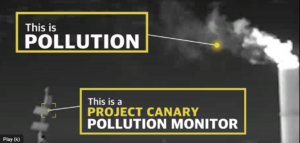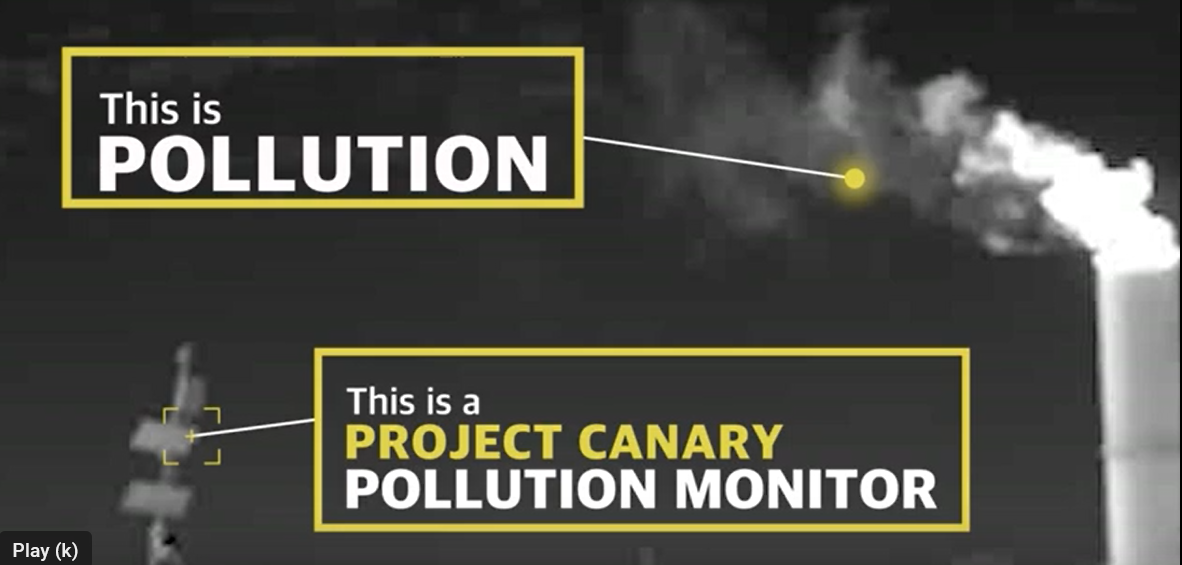
Pressure is growing on U.S. regulators to investigate and radically overhaul U.S. Certified Gas after shocking revelations were published last week in a report by Oil Change International and Earthworks.
Certified gas is a new scheme that U.S. gas producers and LNG exporters are pushing to help clean up America’s reputation for producing dirty methane gas. Essentially, a service company is contracted to monitor and measure emissions at gas sites. Emission sources are meant to be addressed until emissions fall below a threshold below which the service company certifies the gas. Terms for this certified gas include “Responsibly Sourced Gas” and “Differentiated Gas.”
For months, the two organizations undertook a ground-breaking investigation into one of the leading certification companies, Project Canary.
The report, Certified Disaster: How Project Canary and Gas Certification are Misleading Markets & Governments, released last week, has already been described as a “must-read for regulators.” The report’s main findings are:
- Project Canary monitors consistently fail to detect pollution events: Oil and gas certified-thermographers captured alarming evidence of Project Canary monitors failing to detect emissions in the field.
- Greenwashing: Project Canary’s marketing aggressively positions its certification services to justify continued fossil fuel extraction. This is despite the Intergovernmental Panel on Climate Change and International Energy Agency saying that fossil fuel production and consumption must rapidly decline to avoid climate catastrophe.
- Lack of Transparency: Despite claims of ‘radical transparency’ and third-party verification, there is limited access for regulators, academics, or the public to confirm data generated in the certification process.
- Conflicts of Interest: Evidence suggests that a key Project Canary Director and Advisory Board Members have direct financial investments in the same gas companies it certifies.
Last week, Project Canary issued a public rebuttal to the OCI and Earthworks report on its website. Calling the report “inflammatory,” Project Canary said, “we take these charges seriously because we are a mission-driven B-Corp dedicated to deploying the best science, analytics, and technology to help companies precisely measure, mitigate emissions, and improve operations.”
Project Canary’s response concentrated on the 14 pollution events detected by the Earthworks team that were found not to have been picked up by Project Canary monitors. The certification company argued that its monitors had detected emissions increases in 10 of the 14 identified events. While Project Canary tried to spin this as a good thing, it means that Canary’s supposed “class-leading” Canary S monitors failed to detect pollution in thirty percent of the cases identified by Earthworks.
But more importantly, Project Canary completely failed to address all the other issues raised in the report. Here are just four examples:
- The need for regulatory oversight and overhaul of the system, in part due to lack of transparency.
As documented in the report, journalists, academics, and insiders talk about the certification industry as being akin to the “wild west.” One author notes the current situation as “a Wild West frontier filled with mudslinging and smoke and mirrors – and the gunslingers are deciding the rules as they go along.” The fact that the two leading certifiers currently operating in the U.S., MIQ, and Project Canary, use entirely different approaches for certifying gas points to the need for urgent regulatory intervention.
There is evidence of how easy the market is to manipulate. For example, Project Canary’s clients choose which part of their operations are inspected, potentially avoiding sites they know to have issues. In one interview, Chris Romer said, “This is a legitimate criticism of Project Canary: Can companies just cherry-pick their best pads?” Although Romer added that he did not think his clients would “avoid the moral hazard of cherry-picking,” he did not “have the ability to mandate that people do 100 percent” of the gas in their system.
Professor Grant Allen, an airborne and satellite methane monitoring expert from Manchester University in the UK, told us, “At the moment, proprietary quantification methods can be a bit of a black box, and it’s not easy to get information on the methods used. So it needs academic oversight, but with the process being led by regulators to ensure compliance. And methodologies should be peer-reviewed. The emissions data should be public – at least to regulators. This would be the gold standard that could build trust and transparency in any data.”
- Beyond Earthwork’s evidence, numerous scientists told us that the only way to monitor methane pollution effectively is by diversifying techniques.
There is a broad consensus within the emissions monitoring industry that relying too heavily on one technology or technique is a mistake. MiQ’s chief executive, Georges Tijbosch, has criticized Project Canary’s monitoring as relying too heavily on technology that “doesn’t always work right” in the field.
Interviewed for our report, Aaron Van Pelt from QLMtec, which has developed methane camera sensors, says, “Different technologies may work better in one location versus another. For example, for oil wells, it might be point sensors such as cameras; for gas utility pipelines, the best way to measure them is to drive the streets or use drones or helicopters, or planes if you cannot drive. There is no silver bullet. Every technology has a sweet spot and has limitations.”
Van Pelt continues: “A lot of people would agree that all the technologies – point sensors, drones, and satellites – will be needed for progress to be made. There is no single solution yet,” he says.
Leading scientists agree with him. Drew Shindell is an ex-NASA professor of Earth Science at Duke University. He has authored over 250 peer-reviewed publications and received numerous awards. Shindell says: “I would not trust current certification schemes that claim to do direct atmosphere monitoring. They only cover a small area and are often deployed at the best-performing sites. They assume there is an average when it comes to methane emissions. They don’t get a representative sample. Ideally, we need remote sensing from satellites and planes combined with cameras and sensors.”
Professor Grant Allen agrees. “There is no one-size-fits-all approach,” he says.
- Project Canary is helping greenwash the US gas industry’s drive to expand its operations, just as scientists say we cannot drill for any more fossil fuels.
Despite saying it’s an independent auditor of methane emissions, Project Canary aggressively cheerleads for the gas industry. It’s similar to a soccer referee simultaneously playing for Team Gas. You cannot do both.
Pro-gas expansion comments by Canary boss, Chris Romer not only mirror public statements by industry lobbyists such as the International Gas Union and American Petroleum Institute, but Romer spins dirty fracked gas as “the cleanest carbon on the planet.” He adds that we “need to expand LNG globally by a big number.”
Moreover, Romer talks of the need to fix the gas industry’s “brand problem” and how certifying gas as “responsibly sourced” helps restore the industry’s “social license to operate.” One of Project Canary’s main marketing themes is that the certification of methane emissions and the growing “measurement economy” is a crucial strategy to achieve “net zero” or even “real zero.” However, despite such claims, Project Canary does not specifically require its clients to have a net zero target.
Such statements, therefore, point towards certified gas first and foremost as a branding strategy for the gas industry – as a tool to sustain the world’s use of gas rather than to phase it out within climate limits. However, the idea that gas can be ‘net zero’ is in itself greenwashing. The only credible way to reach zero emissions from gas is to stop extracting and burning it.
This is exactly what leading climate scientists told us: For example, Professor James Dyke from the University of Exeter in the UK says, “The bottom line message here is that the greenest [methane] gas is gas that is left in the ground. You don’t have a problem leaking methane emissions if you don’t extract it. Given how razor thin the carbon budgets are for avoiding dangerous climate change, there aren’t any credible arguments that gas can continue to play a significant role.”
Ultimately, what is needed from the oil and gas industry to curb the climate crisis is immediate and rapid action to reduce both methane pollution and oil and gas production within this decade. Project Canary remains in denial about this, as do many in the oil and gas industry.
- Potential conflicts of interest
The company makes several bold claims about its independence on its website. Project Canary says it is “fiercely independent” and “a trusted, honest, ethical, and truly agnostic third party to the whole energy value chain.” Some may argue the entire premise of Project Canary’s business model sets up a conflict of interest. After all, all parties share a financial interest in the process at least appearing to achieve its stated goal.
Aside from this generic conflict of interest, our investigation has found that a key Project Canary Director and Advisory Board Members have direct financial interests in the same gas companies it certifies. At least one of the company’s investors is also heavily invested in its customers. While there is no evidence of any impropriety, the close ties between these company figures and investors and the company’s customers raise questions about whether Project Canary can be considered independent enough to be certifying such a crucial element of a company’s environmental performance, particularly when certified gas can earn the company a premium.
- Is certifed gas the best way to reduce methane emissions?
In the end, there are serious questions to be asked not only about how to regulate certified gas better but whether certified gas is the best way to achieve emissions reductions. Essentially, certified gas is a means for gas companies to profit from what they should be doing in the first place, i.e., reducing methane emissions. The emergence of certified gas implies that methane emissions reduction cannot happen without companies being paid to do it. As if producing, processing, transporting, and storing gas is not profitable enough to pay for emissions reductions.
This is very hard to swallow after a year in which the oil and gas industry made record profits of USD $4 trillion (yes, that’s a t for trillion). Much of this has been channelled straight back to shareholders through increased dividends and share buybacks. Given this, it seems that predicating emissions reductions on gaining a certificate that supports earning a premium on certified gas are not only unnecessary but is giving the industry a pass to reduce emissions only where it benefits them.
It’s time to strictly regulate emissions from the oil and gas industry. There is no more time to waste.


It is not enough to expose the conglomerates that are continually polluting the air we breathe, the water we drink, and the land that we grow our food in. We need to enforce the “checks and balances we supposedly have, in order to stop the irresponsible rape of this WORLD for the sake of P.O.P. Profit Over People. The Supreme Courts of all Nations MUST rule in favor of Health over sickness. Of Life over Death in any and all instances of our abominable dilemma we face now, that past administrations have neglected for decades. Who knows the “Point of NO Return?” I am not willing to bet on it any longer, not should you.
Allan Weiss